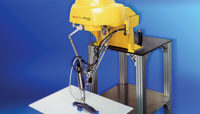In the not-too-distant future, nano air vehicles that resemble insects will play a key role in land-based military operations.
In the not-too-distant future, nano air vehicles (NAVs) that resemble insects will play a key role in land-based military operations. The new class of aircraft will be capable of indoor and outdoor missions to assist troops. Employing biological mimicry at an extremely small scale, NAVs will provide new military reconnaissance capabilities in urban environments.
Two different government agencies are currently working on the technology, along with several universities and aerospace manufacturers. The goal is to develop a variety of mobile micro systems that fly, crawl, hop and hover like flies, spiders, crickets, bees, dragonflies and other insects.
The Defense Advanced Research Projects Agency (DARPA) is spearheading one of the projects. “The NAV program will push the limits of aerodynamic and power conversion efficiency, endurance and maneuverability for very small, flapping wing air vehicle systems,” says Dr. Todd Hylton, DARPA program manager. “The goals of the NAV program-namely to develop an approximately 10-gram aircraft that can hover for extended periods, can fly at forward speeds up to 10 meters per second, can withstand 2.5 meter per second wind gusts, can operate inside buildings, and have up to a kilometer command and control range-will stretch our understanding of flight at these small sizes and require novel technology development.”
AeroVironment Inc. is currently wrapping up Phase II of the multi-year project. The company recently achieved a milestone: The controlled hovering flight of an air vehicle system with two flapping wings that carries its own energy source and uses only the flapping wings for propulsion and control. The nano aircraft is capable of climbing and descending vertically, flying sideways left and right, as well as forward and backward, under remote control.
“From the first day of the Phase I effort, we knew that our biggest challenge would be to develop a viable propulsion system, followed by the extreme challenge of creating a control system for such complex operation at such a small scale,” says Matt Keennon, AeroVironment project manager and principal investigator on the NAV project. “Both systems were extremely difficult to conceive and required an intense combination of creative, scientific and artistic problem-solving skills from several key team members.”
Keennon says the Phase II effort, which is scheduled to continue through this summer, is focusing on optimizing the aircraft for longer flight endurance, establishing the transition capability from hover to forward flight and back, and reducing its size, weight and acoustic signature. “All of these are distinct technical challenges in their own right that actually conflict with each other, making for an interesting and exciting path ahead,” he points out.
The U.S. Army Research Laboratory is also working on an R&D program called the Micro Autonomous Systems and Technology (MAST) Collaborative Technology Alliance. The 10-year initiative is focused on creating the next generation of micro robotic systems for use in urban environments and complex terrain, such as mountains and caves.
“Robotic platforms extend the warfighter's senses and reach, providing operational capabilities that would otherwise be costly, impossible or deadly to achieve,” says Dr. Joseph Mait, MAST cooperative agreement manager for the Army Research Laboratory. “The MAST alliance is a highly collaborative effort, with each partner from government, academia and industry playing a significant role.”
MAST consists of four primary research areas that are under the auspices of several alliance members: Engineers at BAE Systems are working on microsystems integration; the University of Michigan is developing microelectronics; the University of Maryland is responsible for microsystem mechanics; and the University of Pennsylvania is in charge of processing for autonomous operation.
Other institutions involved in the MAST program include California Institute of Technology, Georgia Institute of Technology, North Carolina A&T State University, the University of California Berkeley and the University of New Mexico.
The research teams will create an autonomous, multifunctional collection of miniature intelligence-gathering robots that can operate in places too inaccessible or dangerous for humans. The insect-like robots will be fully autonomous and equipped with a wide variety of visual, acoustic, thermal, magnetic and chemical sensors, in addition to location and orientation capability to assist frontline troops.
Several prototypes have already been created, including a fly-like robot that weighs less than an ounce and has a wing span of 1.18 inches. Lightweight carbon joints allow the robot to mimic a real fly, with wings that beat 110 times a second.
Get our new eMagazine delivered to your inbox every month.
Stay in the know on the latest assembly trends.
SUBSCRIBE TODAY!Copyright ©2024. All Rights Reserved BNP Media.
Design, CMS, Hosting & Web Development :: ePublishing


